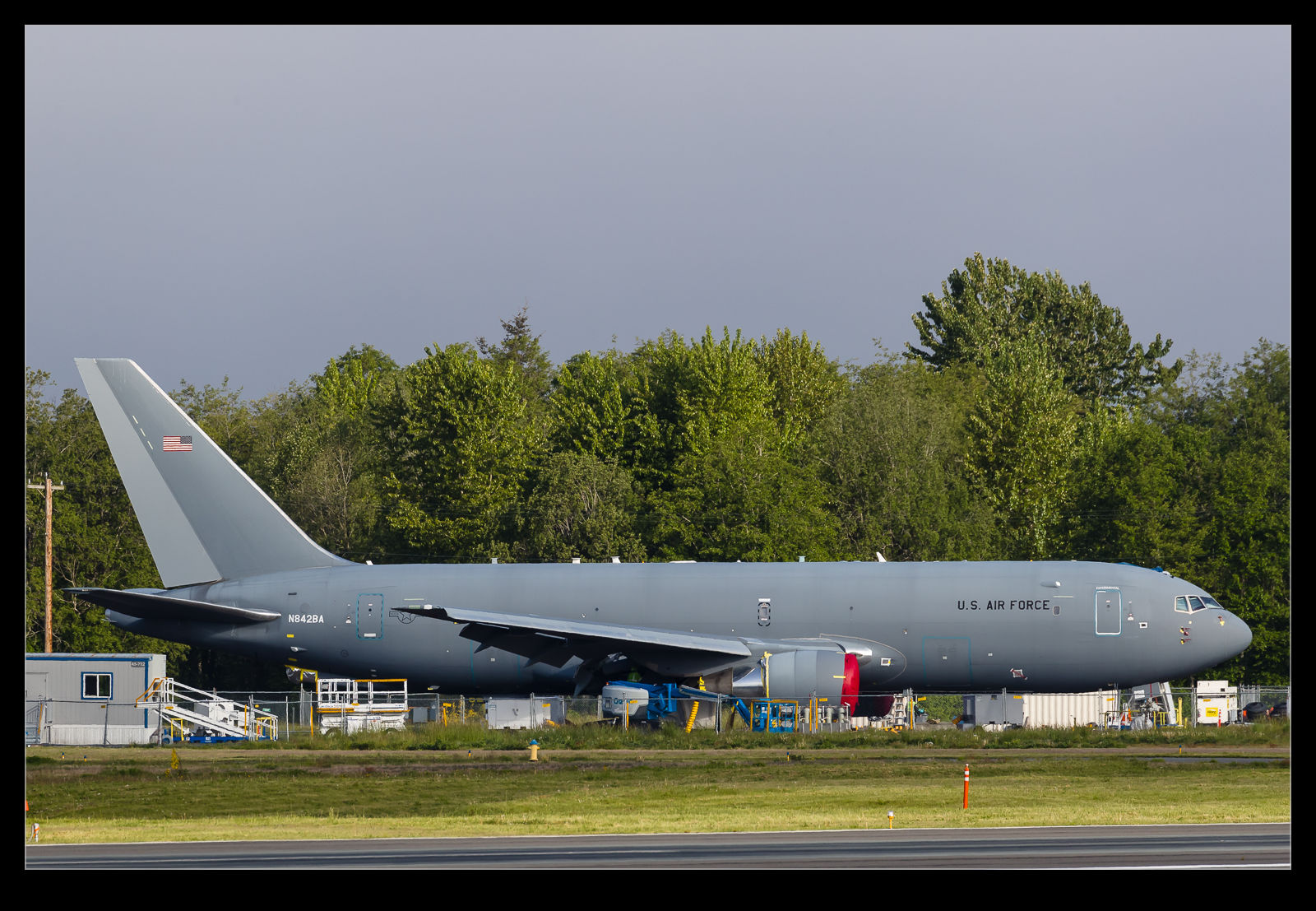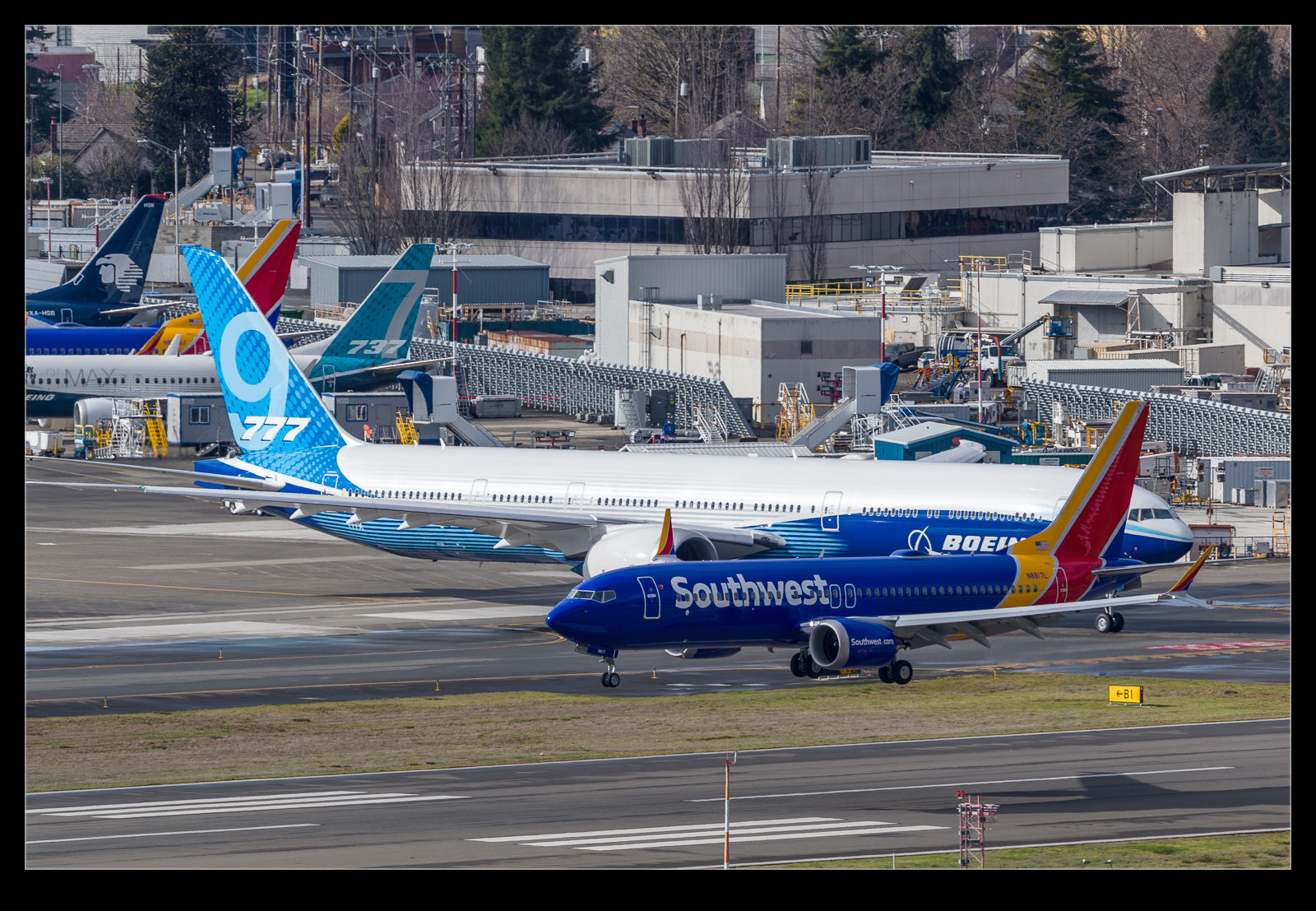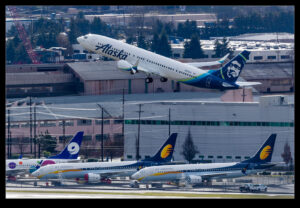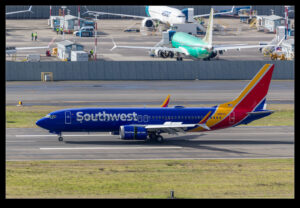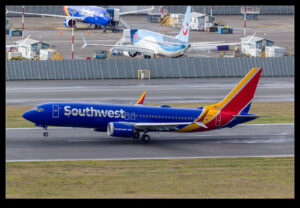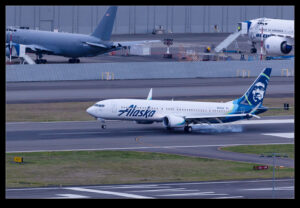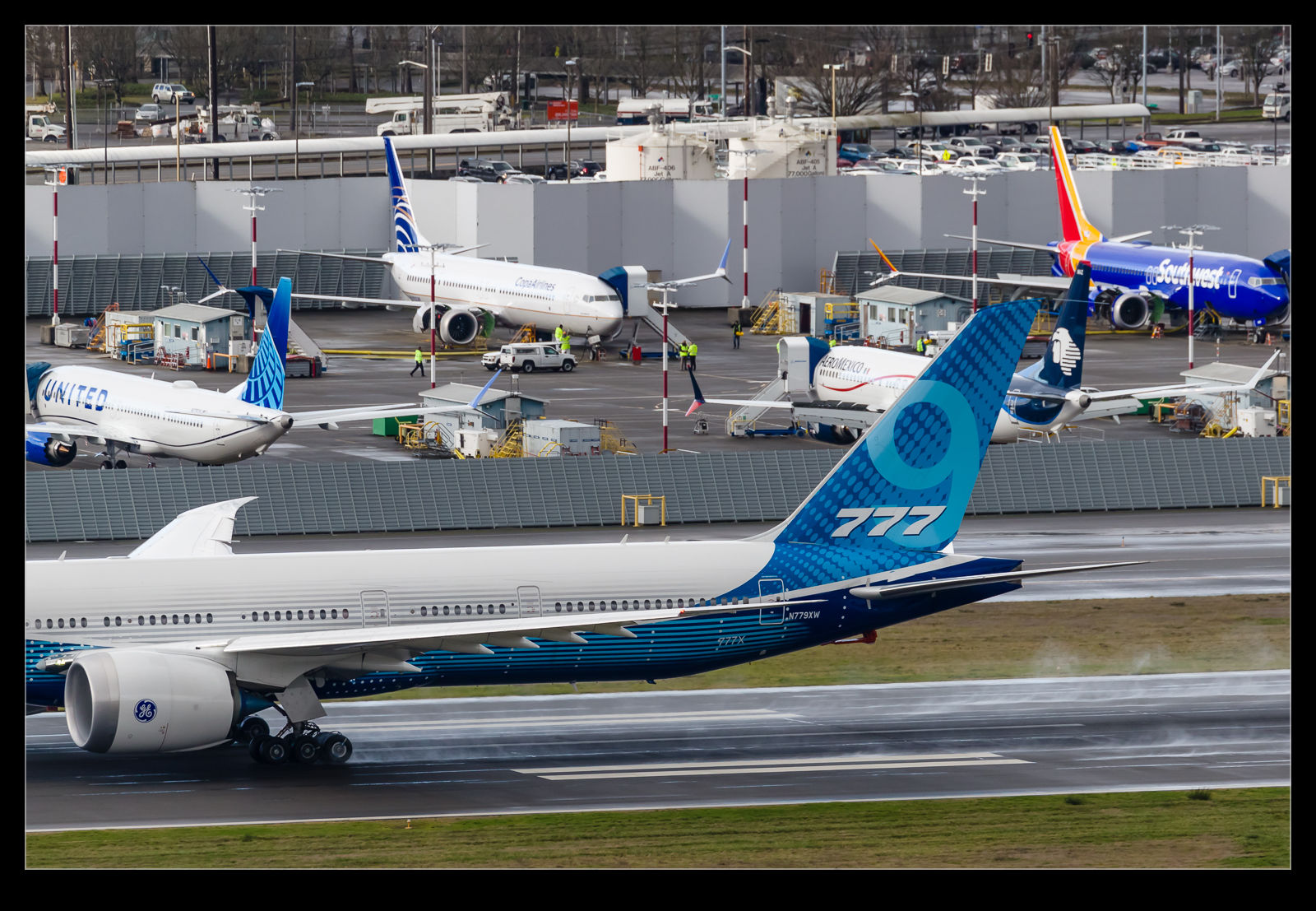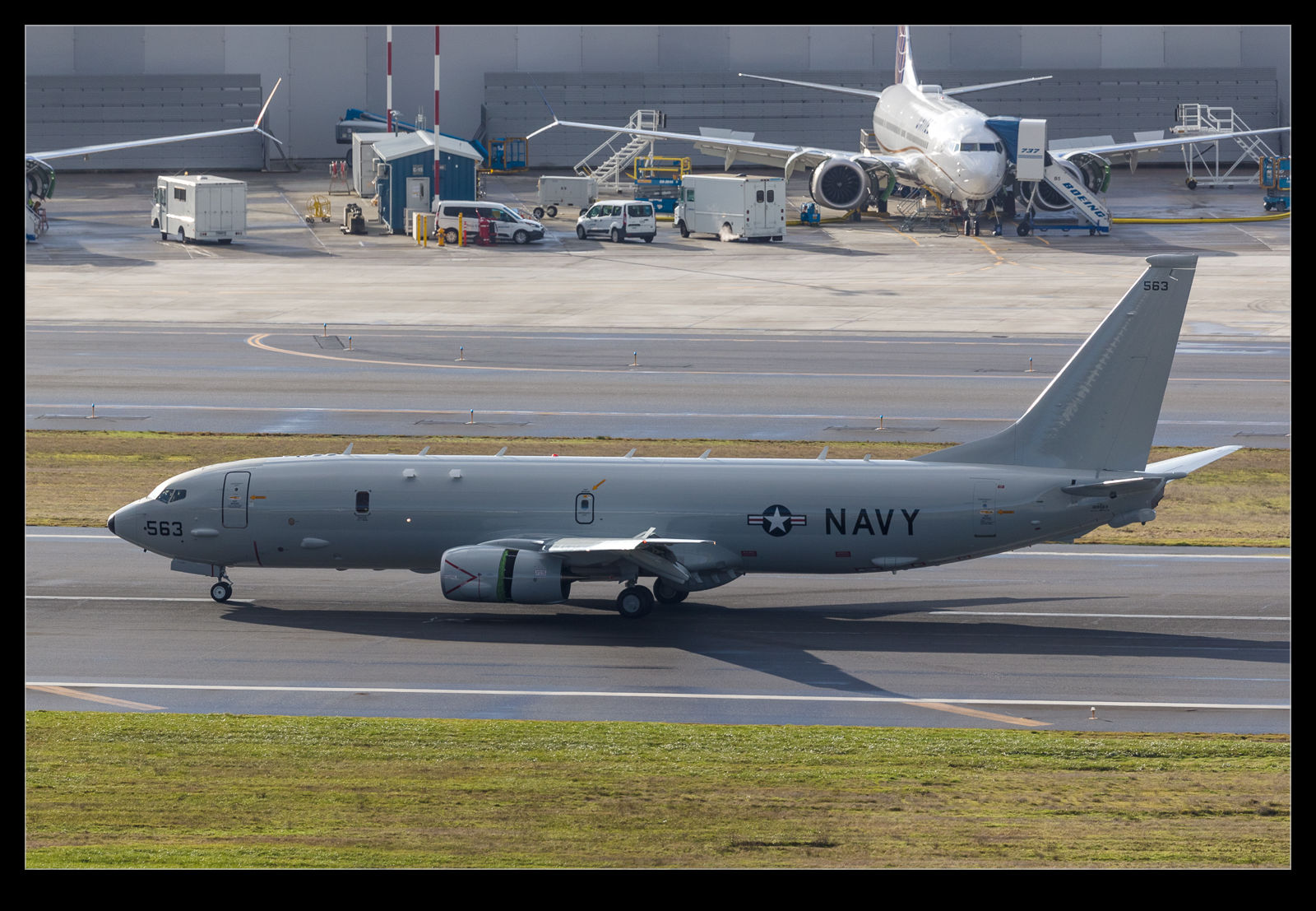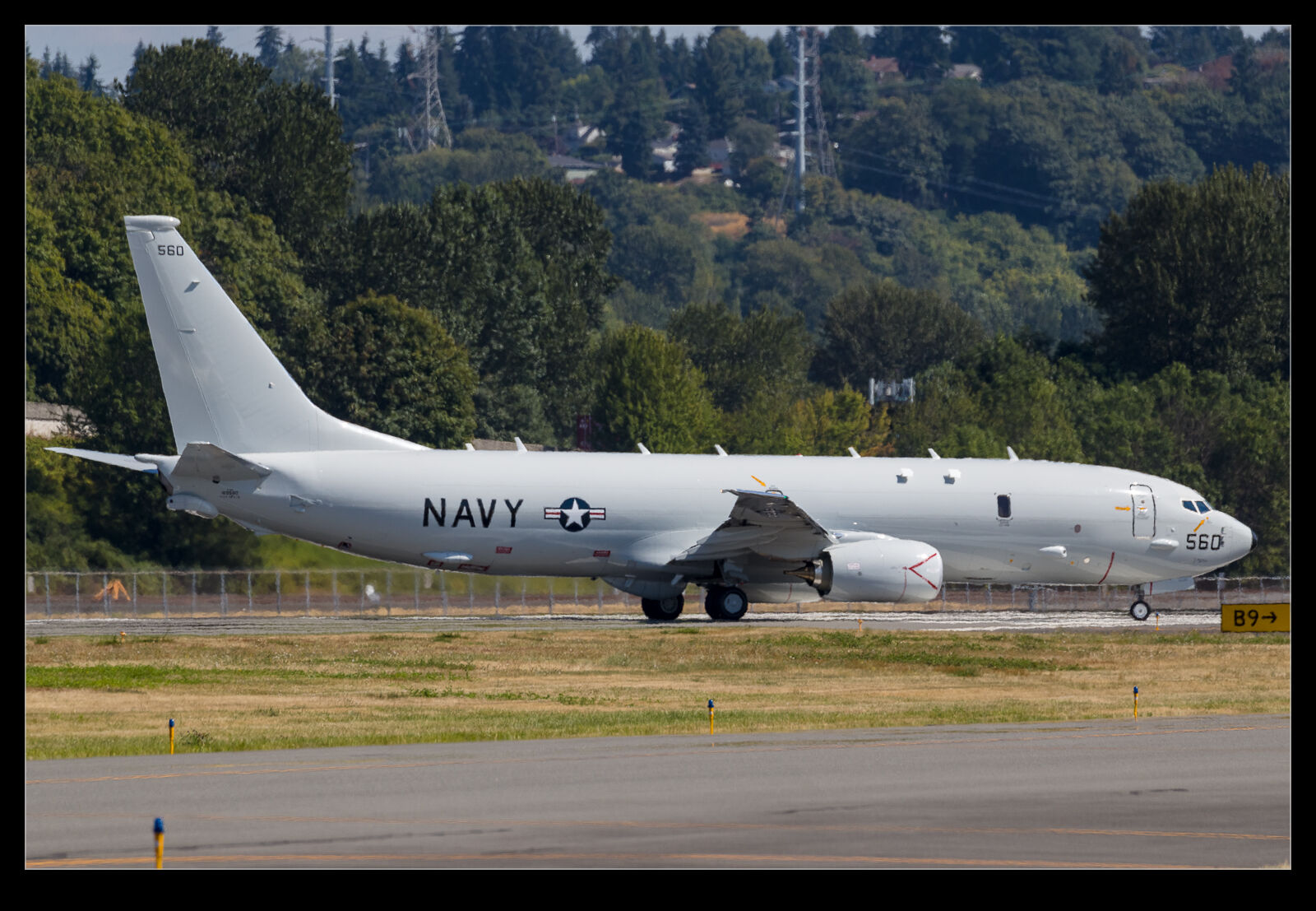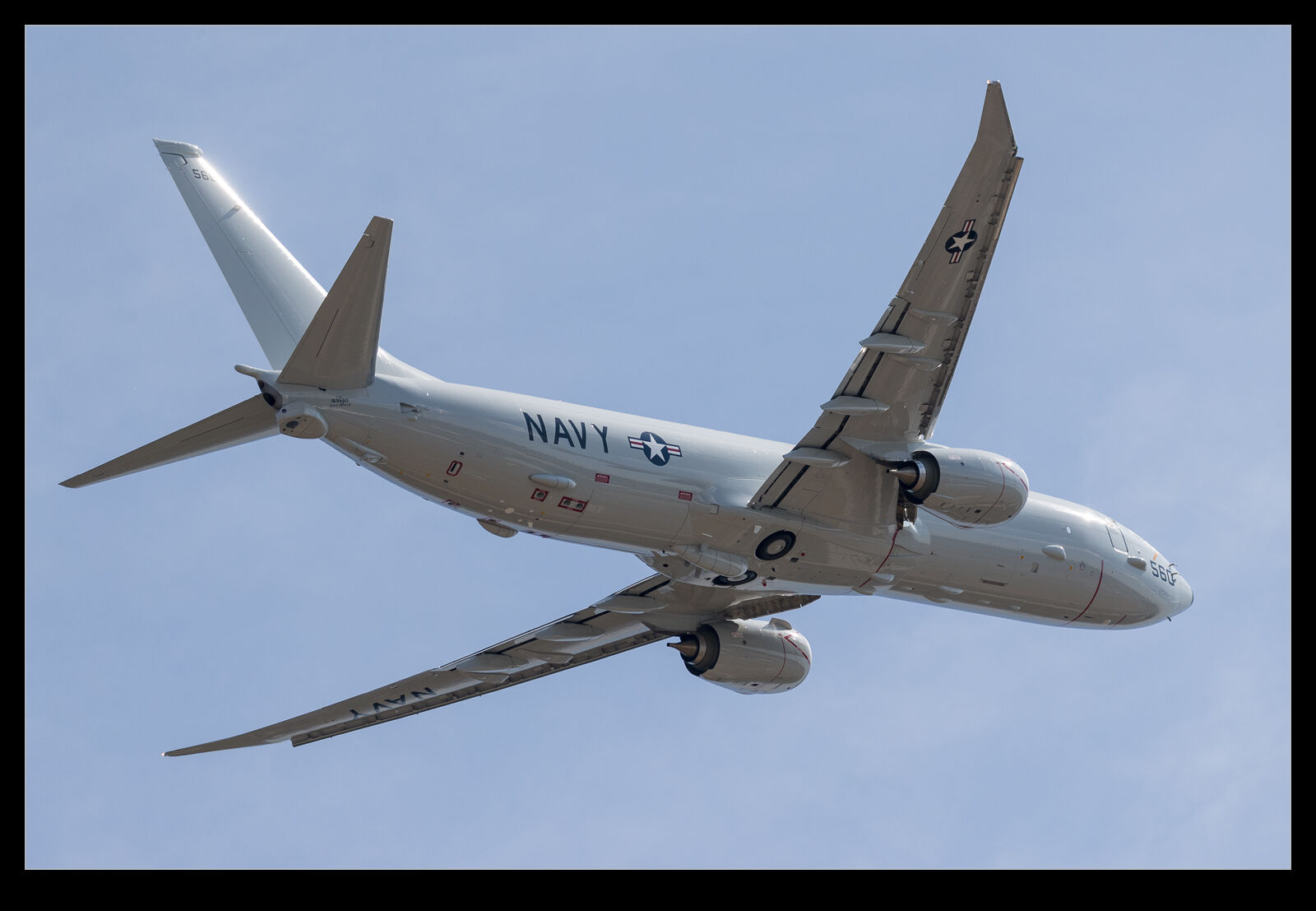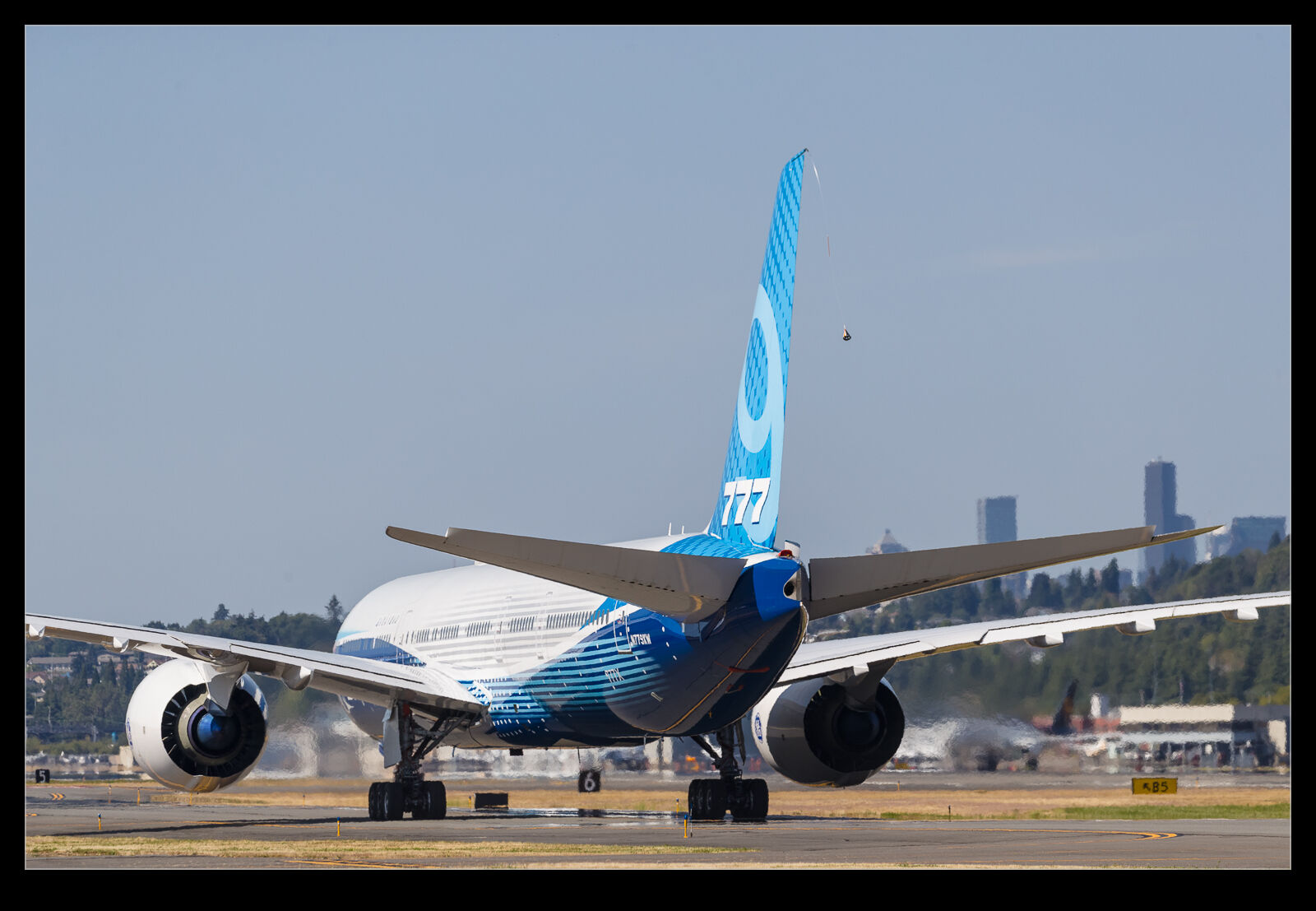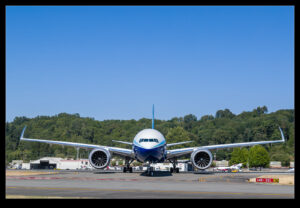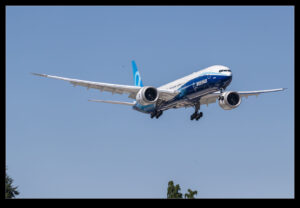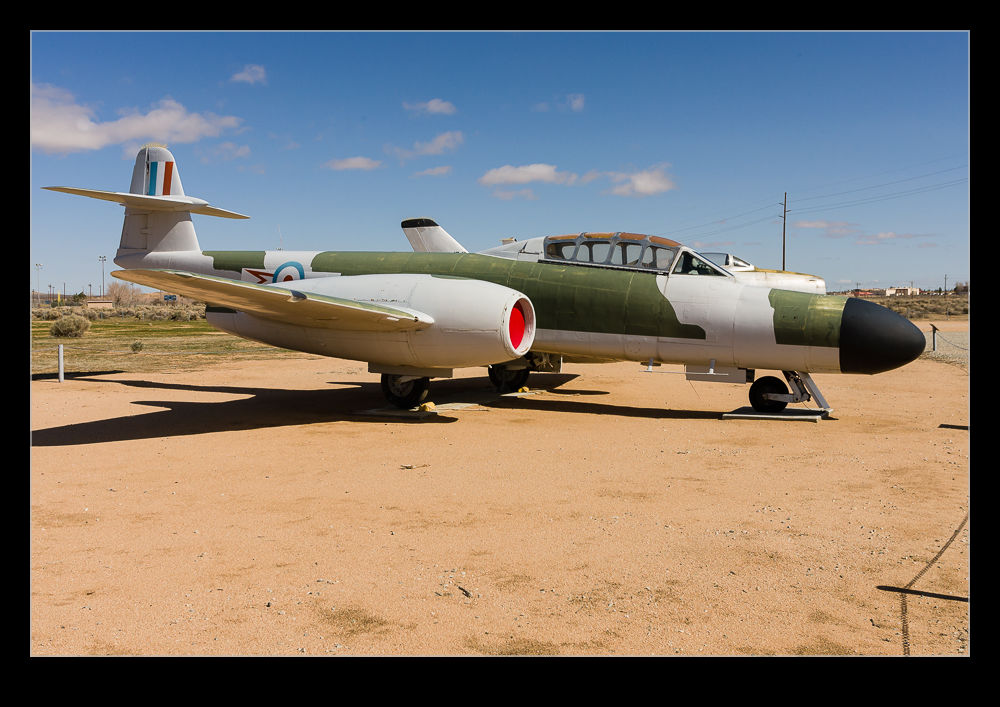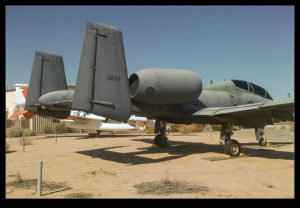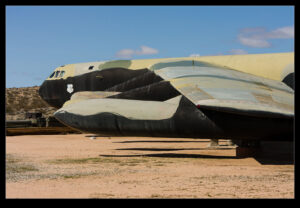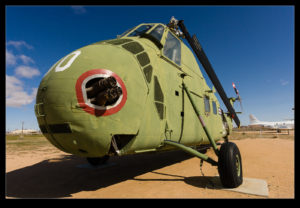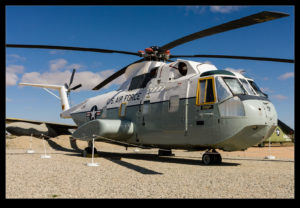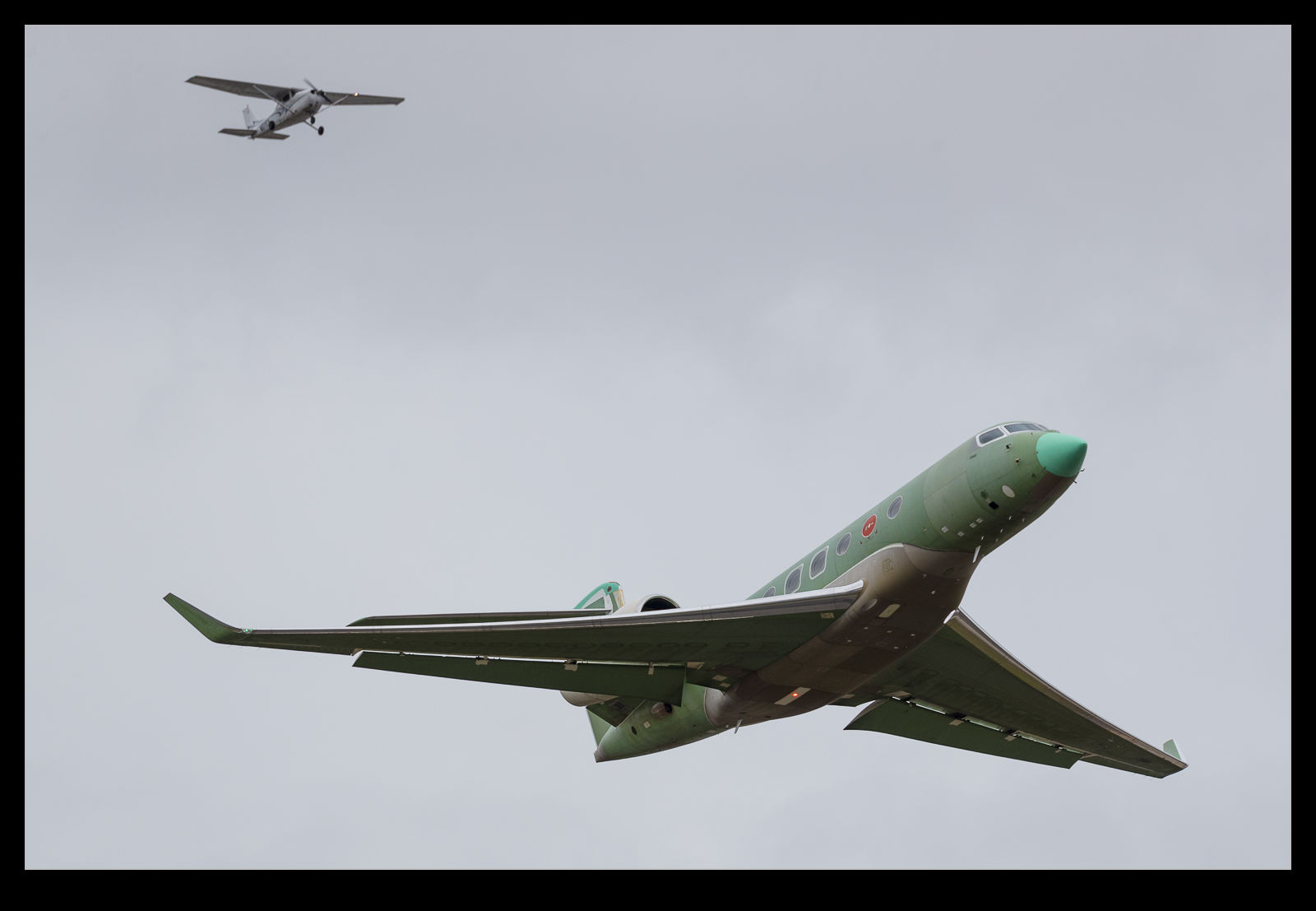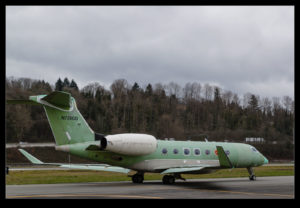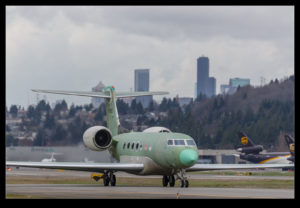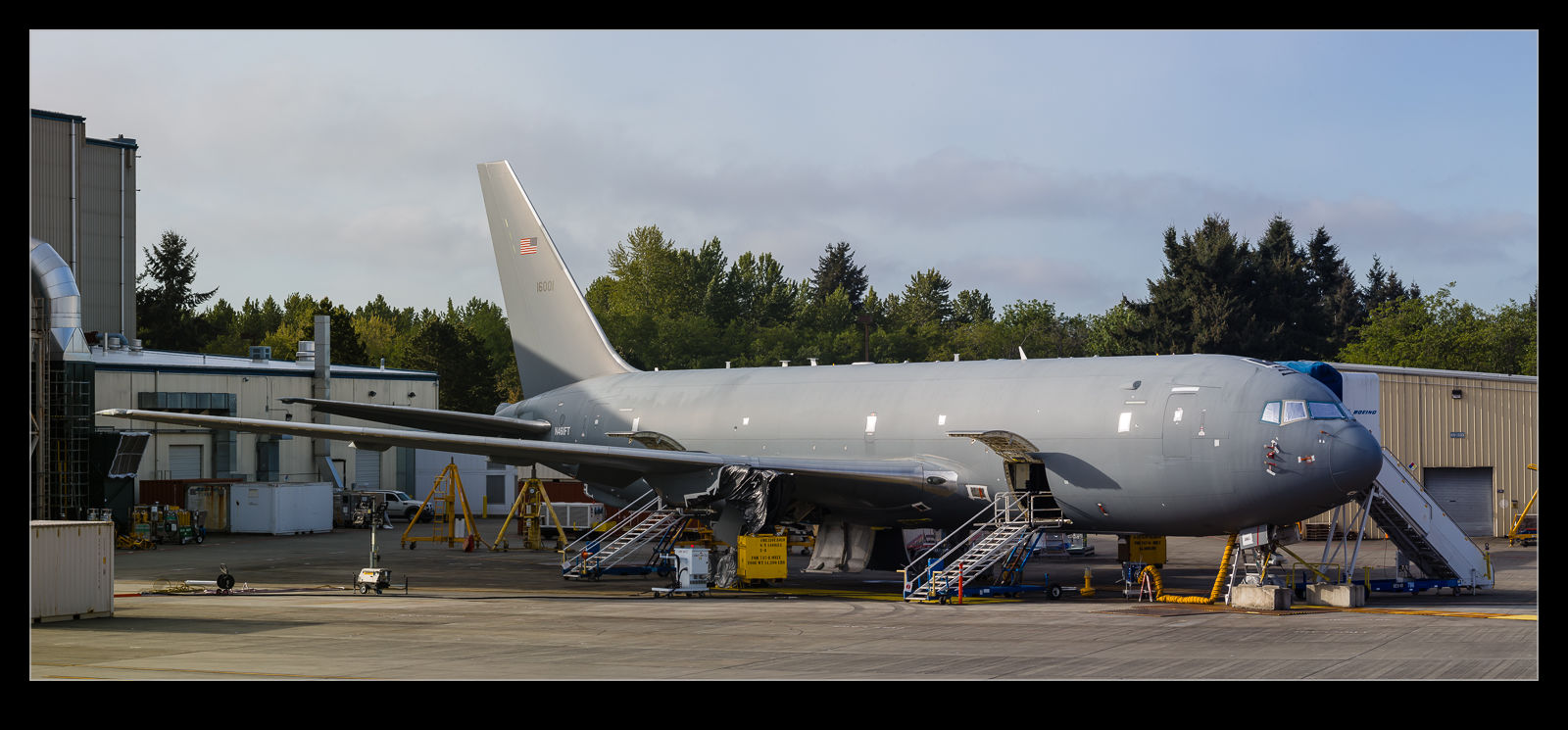 The KC-46 Pegasus program continues to be a problem for Boeing. Delivery rates are lower than planned and articles describing the shortcomings in the jets continue to get circulated. They have a long way to go, and Boeing is going to have to spend a lot more money before they are fully capable. Meanwhile, jet do continue to be built and delivered. The earliest jets were given civil registrations because they were undergoing a civil certification program as well as a military one. Two of those jets are now back at Everett getting reworked – presumably because they will ultimately get delivered to the USAF. I shot a couple of them on the airfield while up there one sunny weekend.
The KC-46 Pegasus program continues to be a problem for Boeing. Delivery rates are lower than planned and articles describing the shortcomings in the jets continue to get circulated. They have a long way to go, and Boeing is going to have to spend a lot more money before they are fully capable. Meanwhile, jet do continue to be built and delivered. The earliest jets were given civil registrations because they were undergoing a civil certification program as well as a military one. Two of those jets are now back at Everett getting reworked – presumably because they will ultimately get delivered to the USAF. I shot a couple of them on the airfield while up there one sunny weekend.
Tag Archives: test
Alaska and Southwest on Test
 The return to airworthiness of the 737 Max was first given in the US so there was a focus on getting airlines deliveries if they were under FAA jurisdiction. I guess we didn’t realize at that point that there would be some follow on issues that resulted in these jets getting grounded but such is the life of the Max watcher. Southwest started taking jets very soon after it was possible and Alaska soon followed with their first delivery – the grounding having come into effect before they had a chance to take their first jet.
The return to airworthiness of the 737 Max was first given in the US so there was a focus on getting airlines deliveries if they were under FAA jurisdiction. I guess we didn’t realize at that point that there would be some follow on issues that resulted in these jets getting grounded but such is the life of the Max watcher. Southwest started taking jets very soon after it was possible and Alaska soon followed with their first delivery – the grounding having come into effect before they had a chance to take their first jet.
 On one day when I was watching the activity at Boeing Field, both airlines had aircraft out on test. They were operating under Boeing flight numbers but it wasn’t possible to tell whether they were production flight tests for Boeing or customer acceptance flights. No doubt I shall see a lot more of both operators with these jets in due course – once Boeing sorts out the latest issues and they become a more reliable part of service!
On one day when I was watching the activity at Boeing Field, both airlines had aircraft out on test. They were operating under Boeing flight numbers but it wasn’t possible to tell whether they were production flight tests for Boeing or customer acceptance flights. No doubt I shall see a lot more of both operators with these jets in due course – once Boeing sorts out the latest issues and they become a more reliable part of service!
Tailskid On A 777X
 There is plenty of the 777X on this blog. The delays for the test programs and the likelihood that service entry will slip in to 2024 means that test aircraft are all that is going to be available for a while yet. Even so, with four test aircraft in use, there is plenty of test activity underway. One of the more dramatic testing processes is the minimum unstick testing.
There is plenty of the 777X on this blog. The delays for the test programs and the likelihood that service entry will slip in to 2024 means that test aircraft are all that is going to be available for a while yet. Even so, with four test aircraft in use, there is plenty of test activity underway. One of the more dramatic testing processes is the minimum unstick testing.
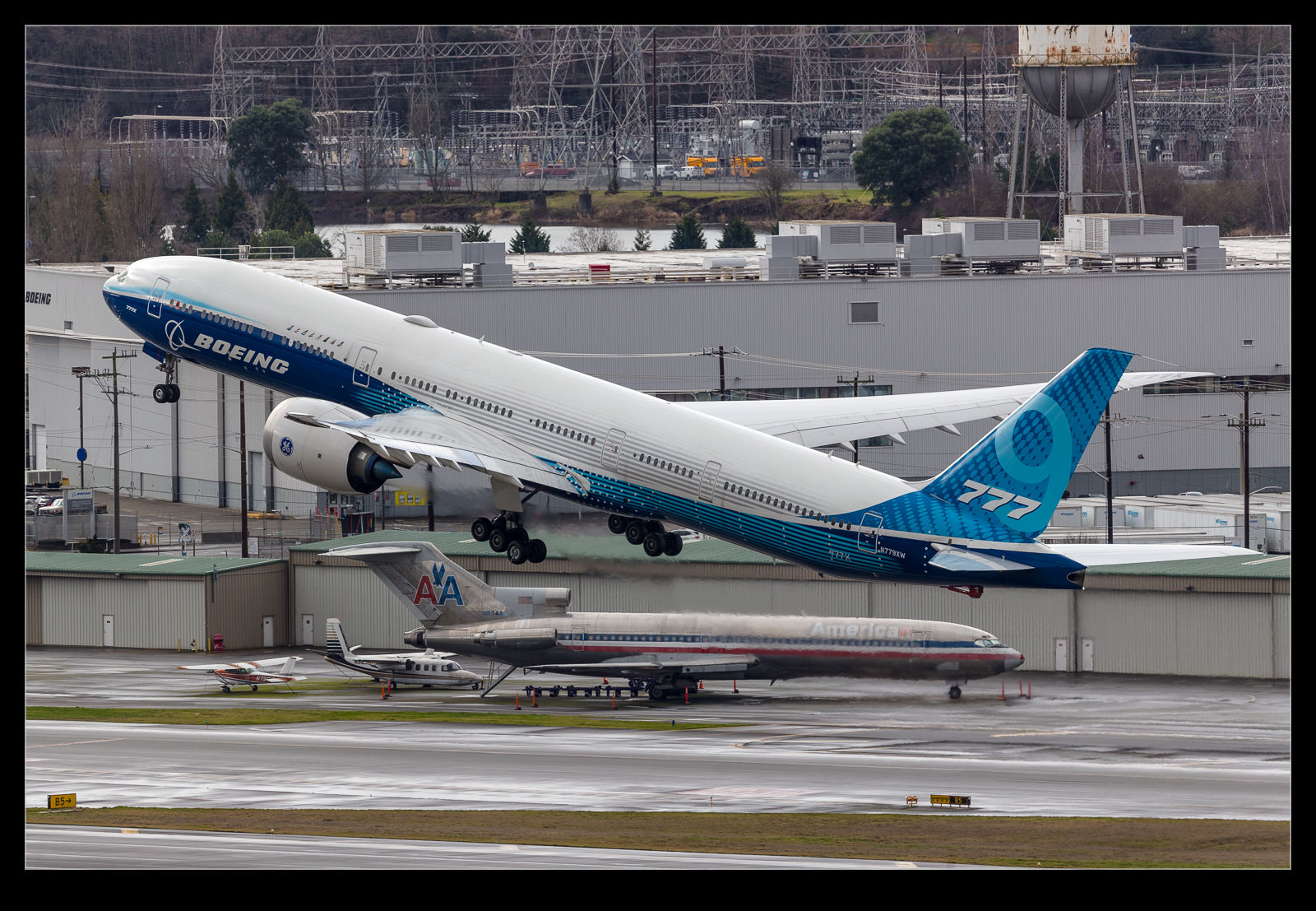 The test is to determine the maximum lift at takeoff in various configurations. This allows calculation of the required take off speeds and the runway distance required. The test involves accelerating the aircraft more slowly than usual and pulling the noise fully up. The tail is dragged along the runway and the aircraft will then get airborne once it reaches sufficient speed.
The test is to determine the maximum lift at takeoff in various configurations. This allows calculation of the required take off speeds and the runway distance required. The test involves accelerating the aircraft more slowly than usual and pulling the noise fully up. The tail is dragged along the runway and the aircraft will then get airborne once it reaches sufficient speed.
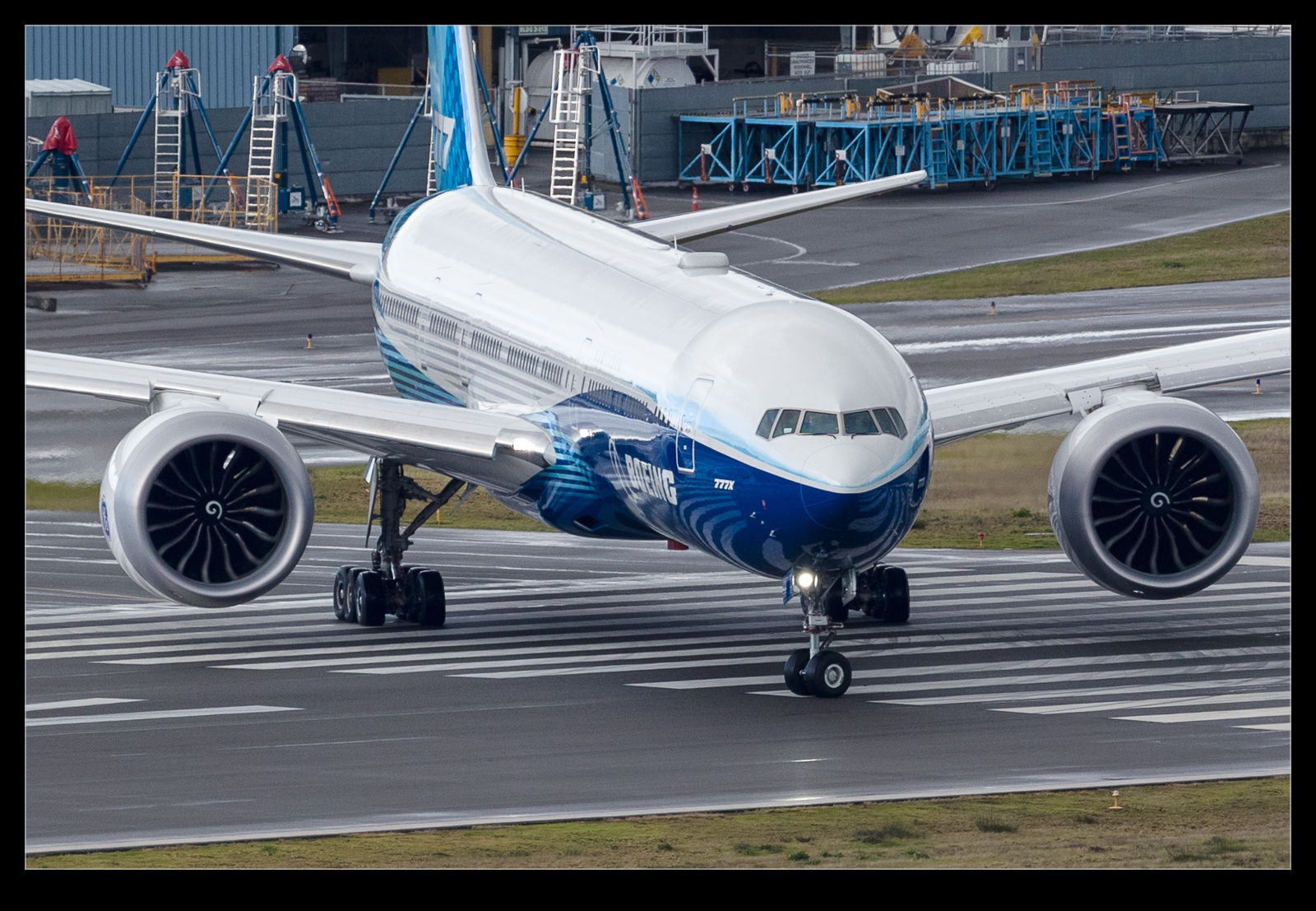 The test requires a decent runway length and, presumably, nothing much off the end should anything go awry. To protect the aircraft, a tailskid is fitted to the rear fuselage to allow the crew to drag it along the runway surface without damaging the airframe. The skid frame is a metallic structure but I am not sure what the wearing surface is for the 777X. In the past, wood has been used as the abradable element.
The test requires a decent runway length and, presumably, nothing much off the end should anything go awry. To protect the aircraft, a tailskid is fitted to the rear fuselage to allow the crew to drag it along the runway surface without damaging the airframe. The skid frame is a metallic structure but I am not sure what the wearing surface is for the 777X. In the past, wood has been used as the abradable element.
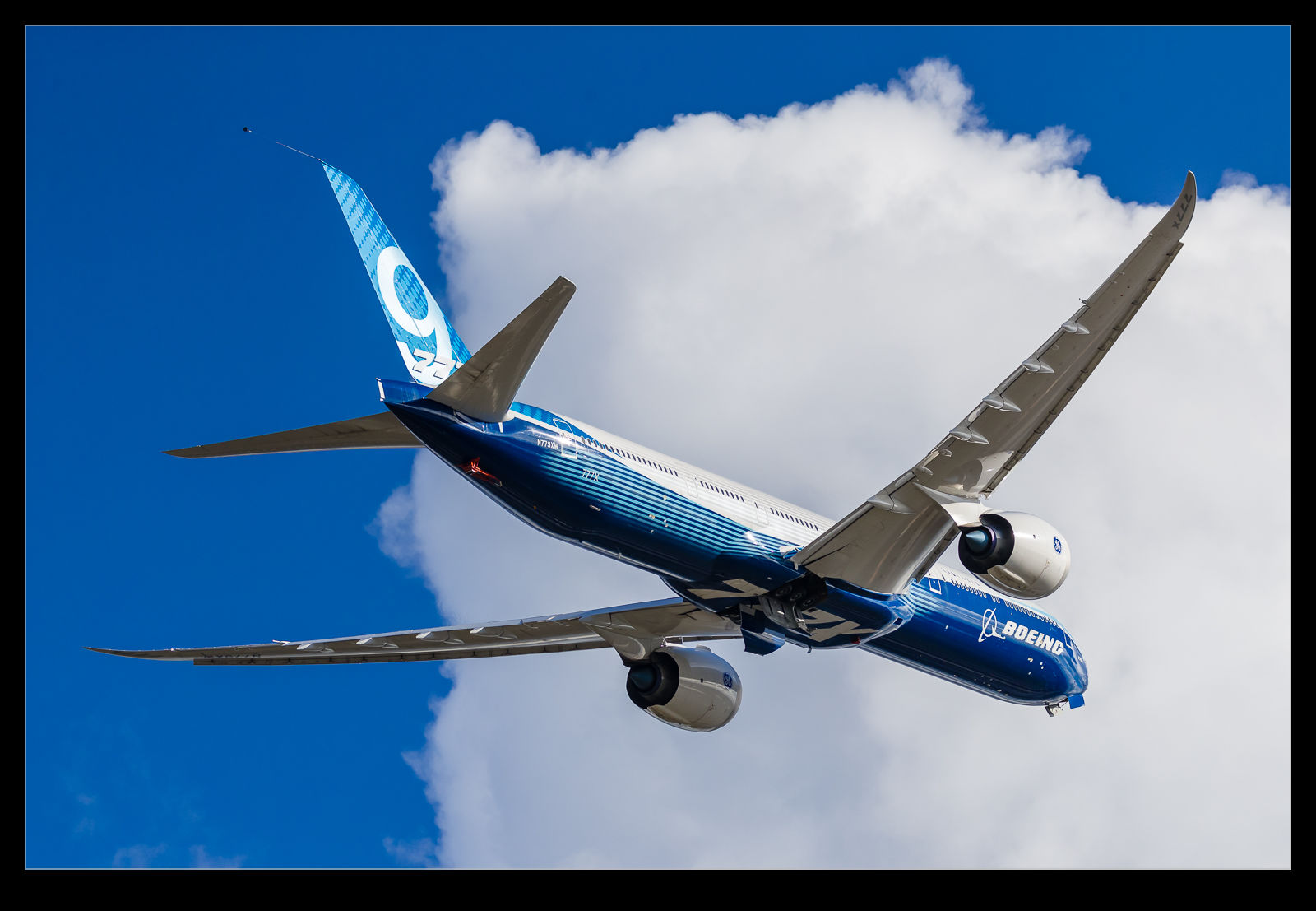 WH001, the first 777-9 airframe, is the one that is going to be used for these tests. It has been fitted with the skid. I’m not sure whether the testing is already underway or whether it is ready for future use. I shot it on departure on a couple of occasions.
WH001, the first 777-9 airframe, is the one that is going to be used for these tests. It has been fitted with the skid. I’m not sure whether the testing is already underway or whether it is ready for future use. I shot it on departure on a couple of occasions.
Return of a P-8 Test Flight From Above
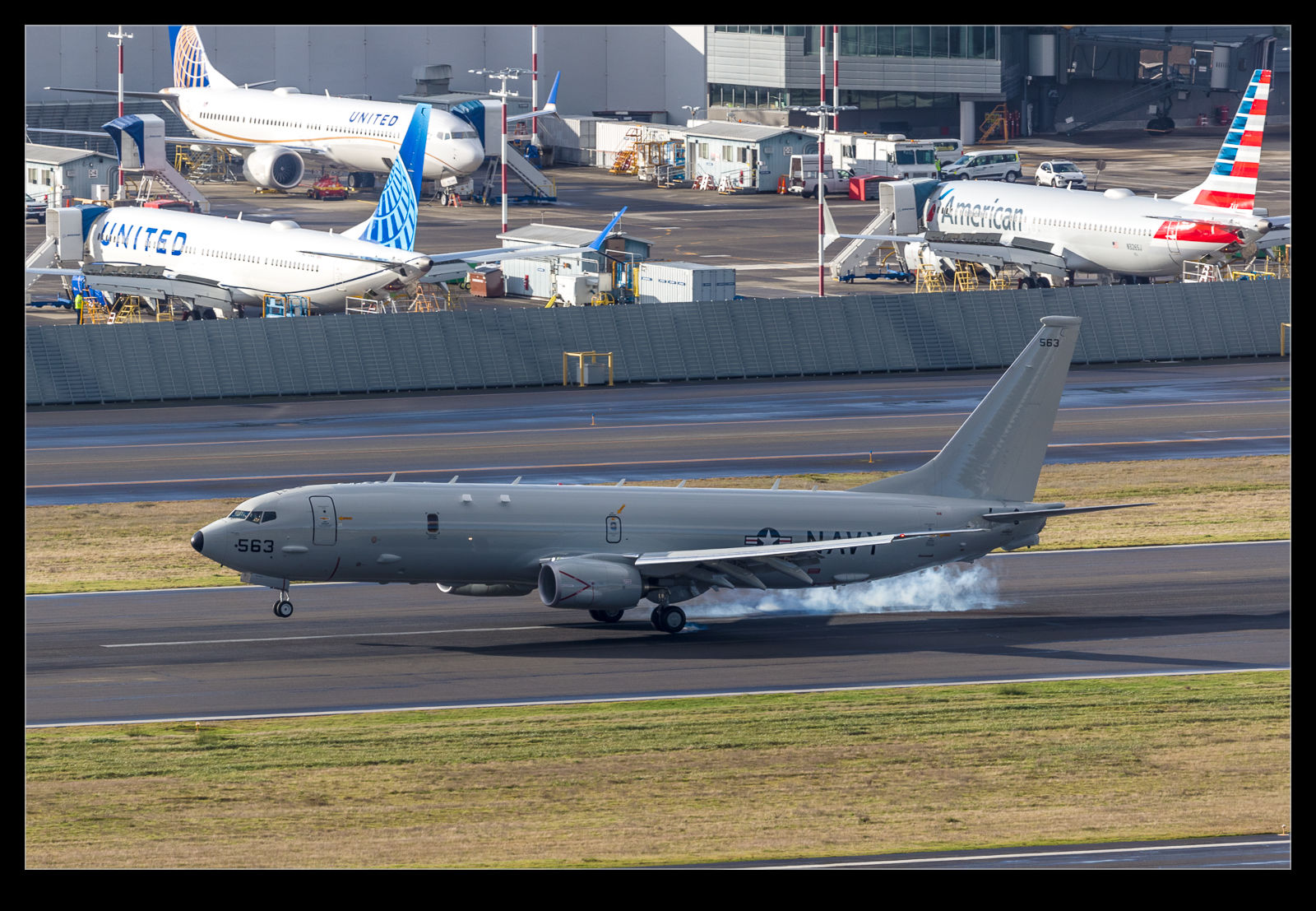 The first decent sized arrival I got on my BFI visit was a US Navy P-8 Poseidon returning from a test flight. It gave me a chance to get the hang of picking the arriving planes up against the background and working out their positions as the are on final. Things are pretty cluttered in the background which doesn’t help make a photo look interesting but, once they are over the airfield itself, the background is a lot cleaner and the plane stands out more.
The first decent sized arrival I got on my BFI visit was a US Navy P-8 Poseidon returning from a test flight. It gave me a chance to get the hang of picking the arriving planes up against the background and working out their positions as the are on final. Things are pretty cluttered in the background which doesn’t help make a photo look interesting but, once they are over the airfield itself, the background is a lot cleaner and the plane stands out more.
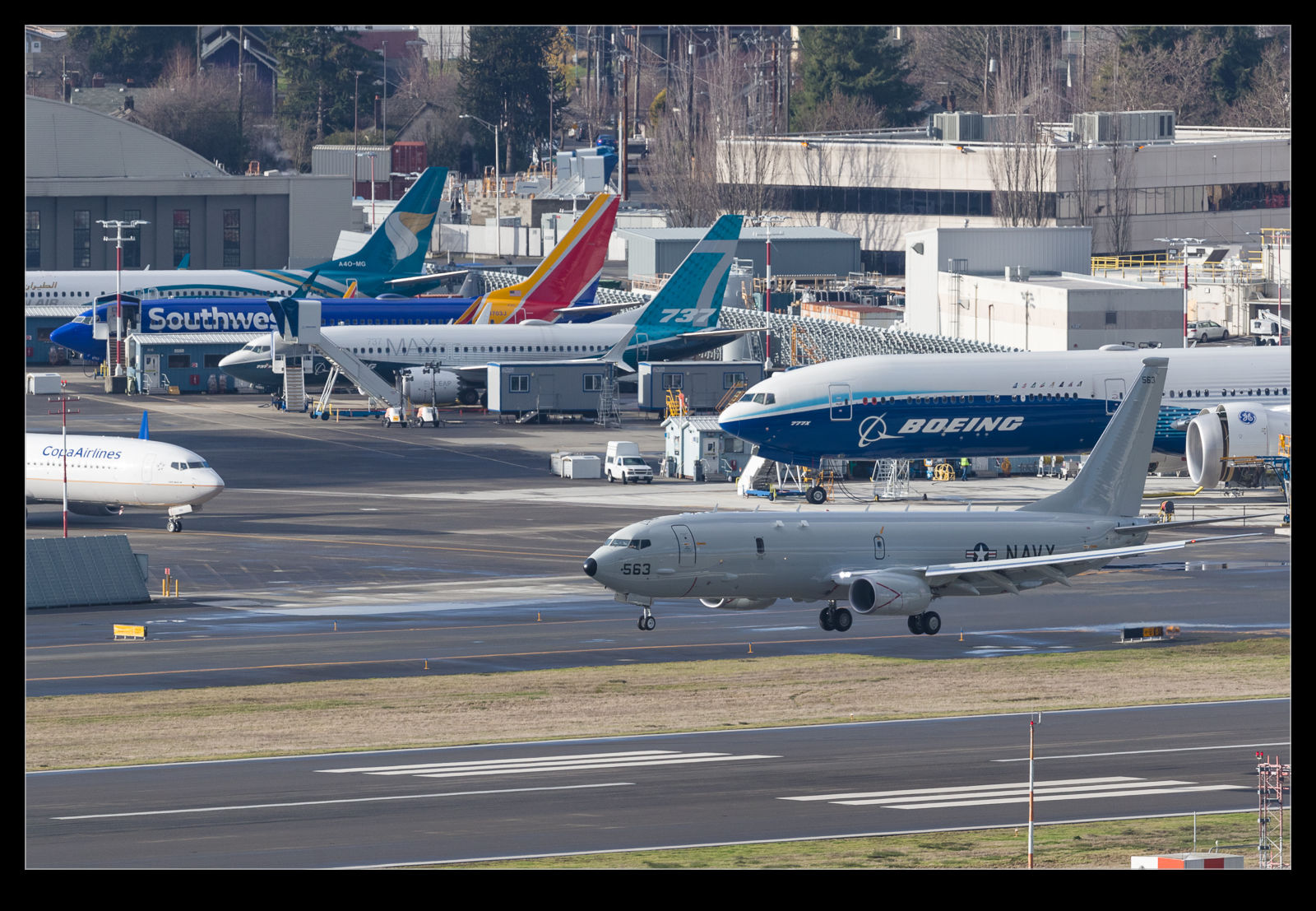 Once over the runway, everything is unobstructed so you get a good view of the touchdown and roll out. The runway wasn’t too damp so not much in the way of spray from reverse thrust but a good amount of tire smoke as the mains hit the ground. Heat haze was not too much of a problem as the conditions were not too sunny but you still had to be pretty close in before the shots were sharp enough to look at closely.
Once over the runway, everything is unobstructed so you get a good view of the touchdown and roll out. The runway wasn’t too damp so not much in the way of spray from reverse thrust but a good amount of tire smoke as the mains hit the ground. Heat haze was not too much of a problem as the conditions were not too sunny but you still had to be pretty close in before the shots were sharp enough to look at closely.
US Navy P-8 Test Flight
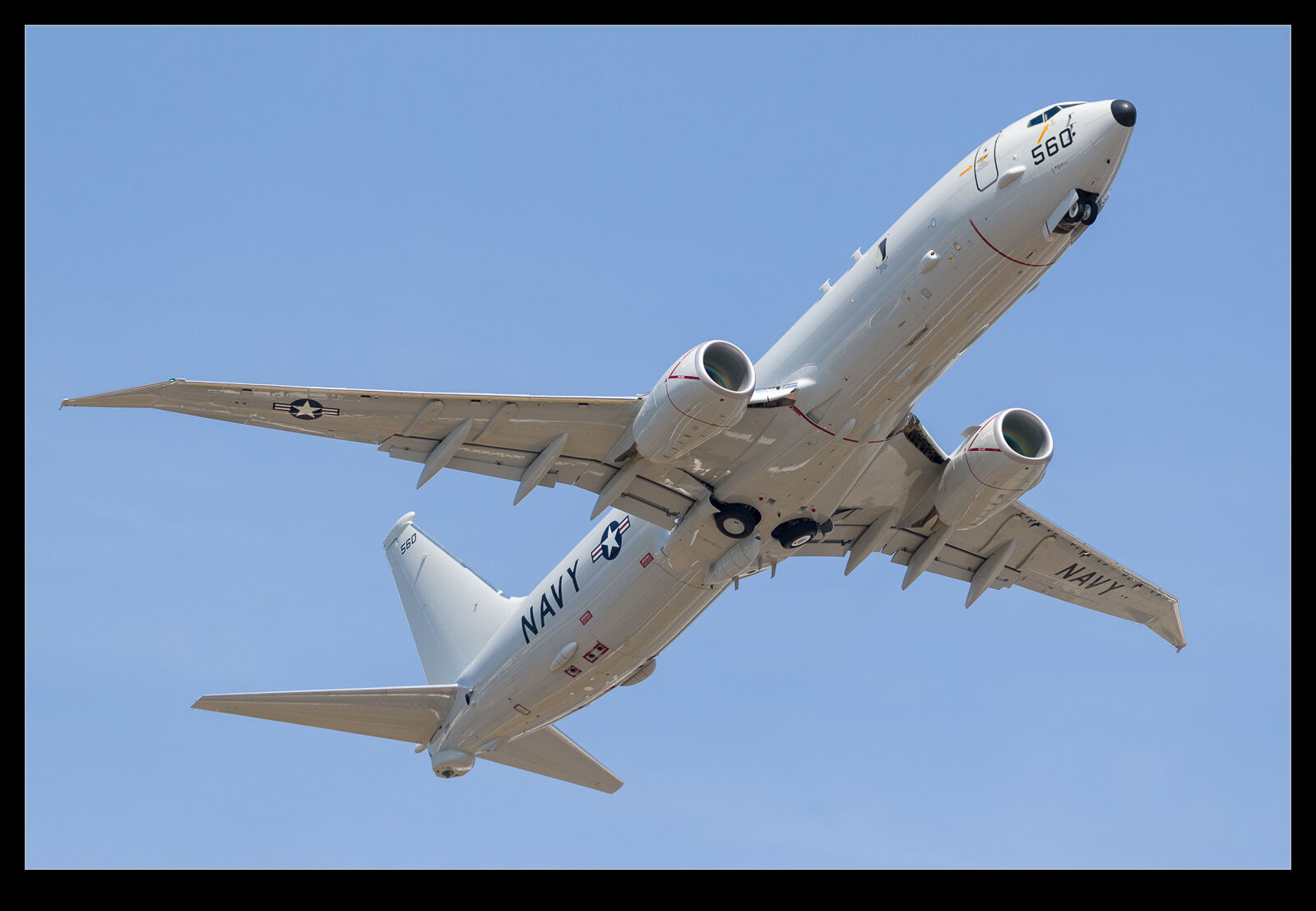 Boeing Field always has the possibility of something interesting going on and a P-8 test flight for a US Navy jet was on the cards while I was there a while back. Even better news was that it wasn’t a long flight that they had planned. Consequently, I was going to be there for both departure and return. Since the jet was lightly loaded, takeoff was not labored and they were well up by the time they were close to me. Still, not a big angle on the jet with the light as it was.
Boeing Field always has the possibility of something interesting going on and a P-8 test flight for a US Navy jet was on the cards while I was there a while back. Even better news was that it wasn’t a long flight that they had planned. Consequently, I was going to be there for both departure and return. Since the jet was lightly loaded, takeoff was not labored and they were well up by the time they were close to me. Still, not a big angle on the jet with the light as it was.
 I didn’t head to the approach end for the return as I was waiting for something else. It did mean I was closer to the jet as it rolled out on is landing run. The military ramp for Boeing is at that end of the field so the jet rolled to the end and turned off. Heat haze is always a problem at this time of year but things looked surprisingly good considering.
I didn’t head to the approach end for the return as I was waiting for something else. It did mean I was closer to the jet as it rolled out on is landing run. The military ramp for Boeing is at that end of the field so the jet rolled to the end and turned off. Heat haze is always a problem at this time of year but things looked surprisingly good considering.
Two Out of Three 777X
 The test program for the Boeing 777X is gradually increasing and a third jet has been added to the fleet. I stopped by Boeing Field because all three jets were scheduled to fly on this day. Having seen the first two, I was hoping for the third since I haven’t got any shots of it and its livery which is different to the first two. Sadly, I was to be disappointed as they scrubbed the flight.
The test program for the Boeing 777X is gradually increasing and a third jet has been added to the fleet. I stopped by Boeing Field because all three jets were scheduled to fly on this day. Having seen the first two, I was hoping for the third since I haven’t got any shots of it and its livery which is different to the first two. Sadly, I was to be disappointed as they scrubbed the flight.
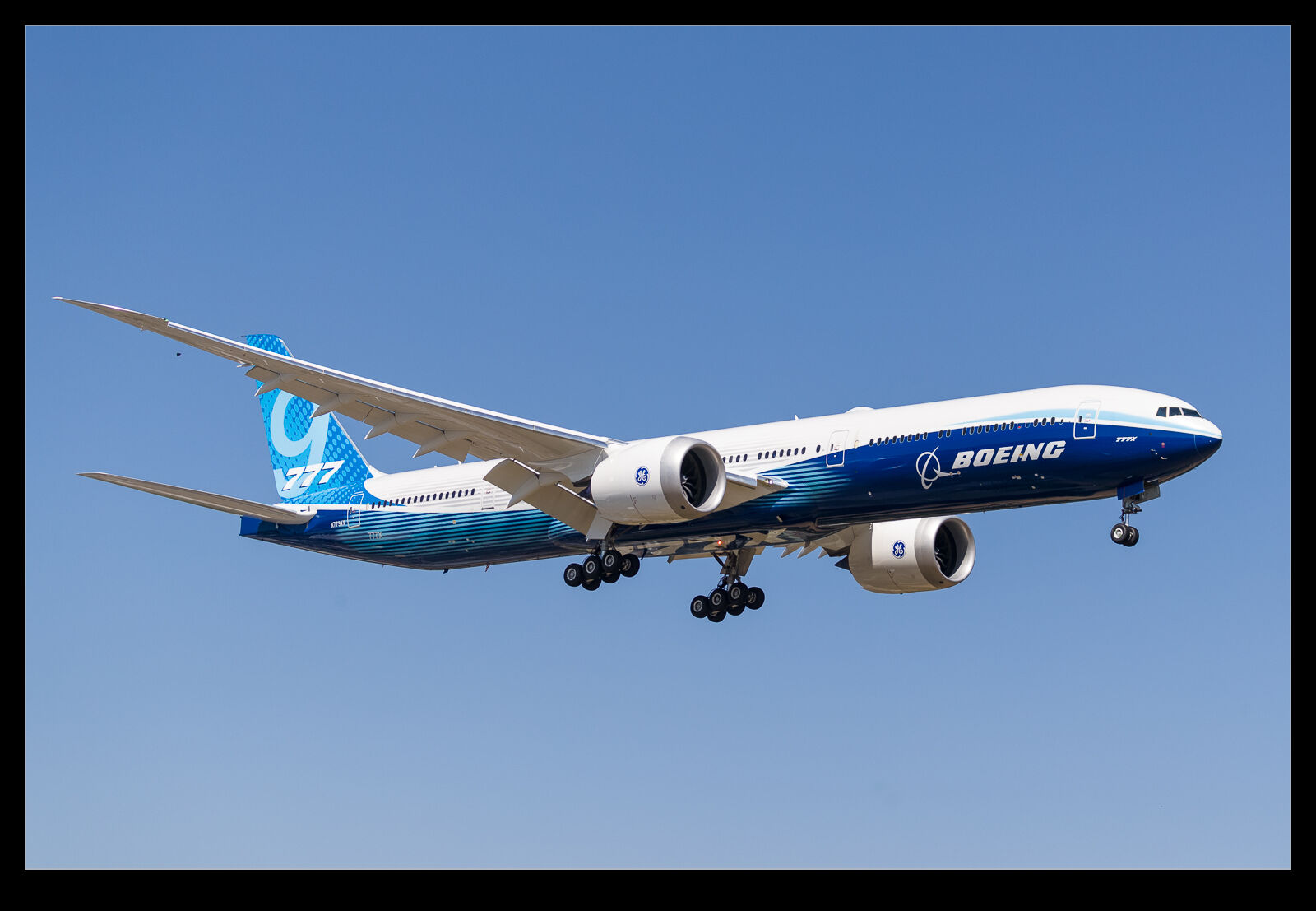 However, the first two jets did fly. They were both already airborne by the time I got there. The arrival times back for both were supposed to be pretty close but you can’t put too much stock in those times as things on test will be what they will be. I headed to the arrival end for the first of them. It wasn’t that late so the light wasn’t ideal but it was still a bit better as we were well passed the solstice and heading to the equinox. Happy to take the shot of course.
However, the first two jets did fly. They were both already airborne by the time I got there. The arrival times back for both were supposed to be pretty close but you can’t put too much stock in those times as things on test will be what they will be. I headed to the arrival end for the first of them. It wasn’t that late so the light wasn’t ideal but it was still a bit better as we were well passed the solstice and heading to the equinox. Happy to take the shot of course.
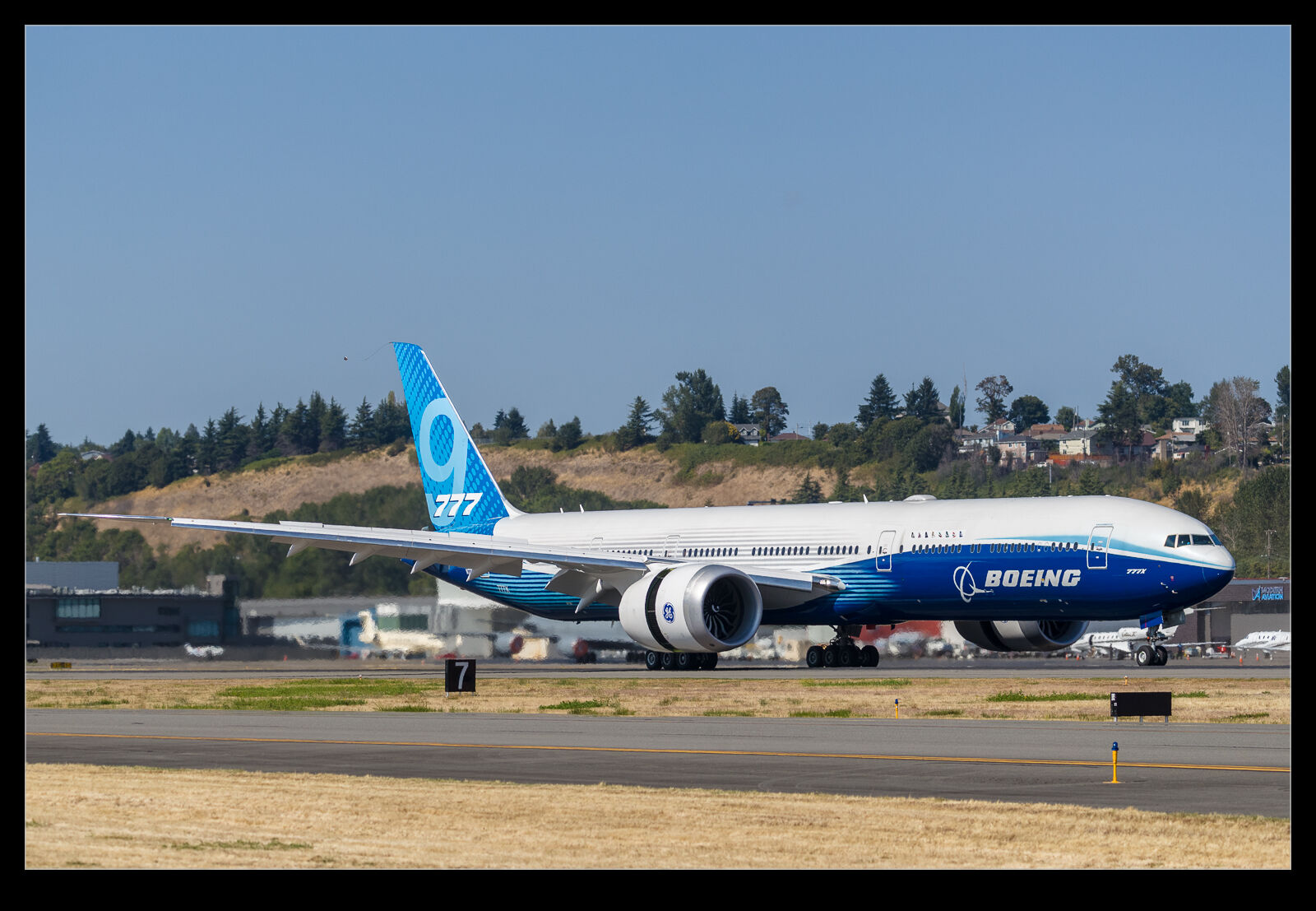 I moved to the other end of the field when the second jet came in. I wasn’t interested in repeating the shot I had already taken (plus I had shot this jet in similar circumstances before) so some images at the other end seemed worthwhile. They landed short but had clearance for a high speed run on the runway so that brought them down to where I was. Fortuitously, they took the exit directly in front of me. I missed the transition of the wingtips while changing cameras. The tips were down in one set of shots but were folded as they taxied off the runway. The wide angle view is a nice one to get of something so large.
I moved to the other end of the field when the second jet came in. I wasn’t interested in repeating the shot I had already taken (plus I had shot this jet in similar circumstances before) so some images at the other end seemed worthwhile. They landed short but had clearance for a high speed run on the runway so that brought them down to where I was. Fortuitously, they took the exit directly in front of me. I missed the transition of the wingtips while changing cameras. The tips were down in one set of shots but were folded as they taxied off the runway. The wide angle view is a nice one to get of something so large.
Lockheed Martin Test Assets
 An early ISAP symposium included a visit to Lockheed Martin’s facility at Fort Worth. We were there to see the first F-35 test aircraft, AA-1. In addition, they had arranged to bring Glacier Girl, a P-38 Lightning, to be there too to provide two Lockheed Lightnings. However, while I was up the scissor lift that was provided for us to get an elevated view, I looked the opposite direction. There were two interesting looking airframes parked up. One was an old F-16 that had probably been used for test duties. The other was not a flyable plane but it was some sort of test rig for the STOVL configuration of the F-35 – what would become the F-35B. A couple of cool looking items that you wouldn’t normally get to see.
An early ISAP symposium included a visit to Lockheed Martin’s facility at Fort Worth. We were there to see the first F-35 test aircraft, AA-1. In addition, they had arranged to bring Glacier Girl, a P-38 Lightning, to be there too to provide two Lockheed Lightnings. However, while I was up the scissor lift that was provided for us to get an elevated view, I looked the opposite direction. There were two interesting looking airframes parked up. One was an old F-16 that had probably been used for test duties. The other was not a flyable plane but it was some sort of test rig for the STOVL configuration of the F-35 – what would become the F-35B. A couple of cool looking items that you wouldn’t normally get to see.
The Edwards Museum
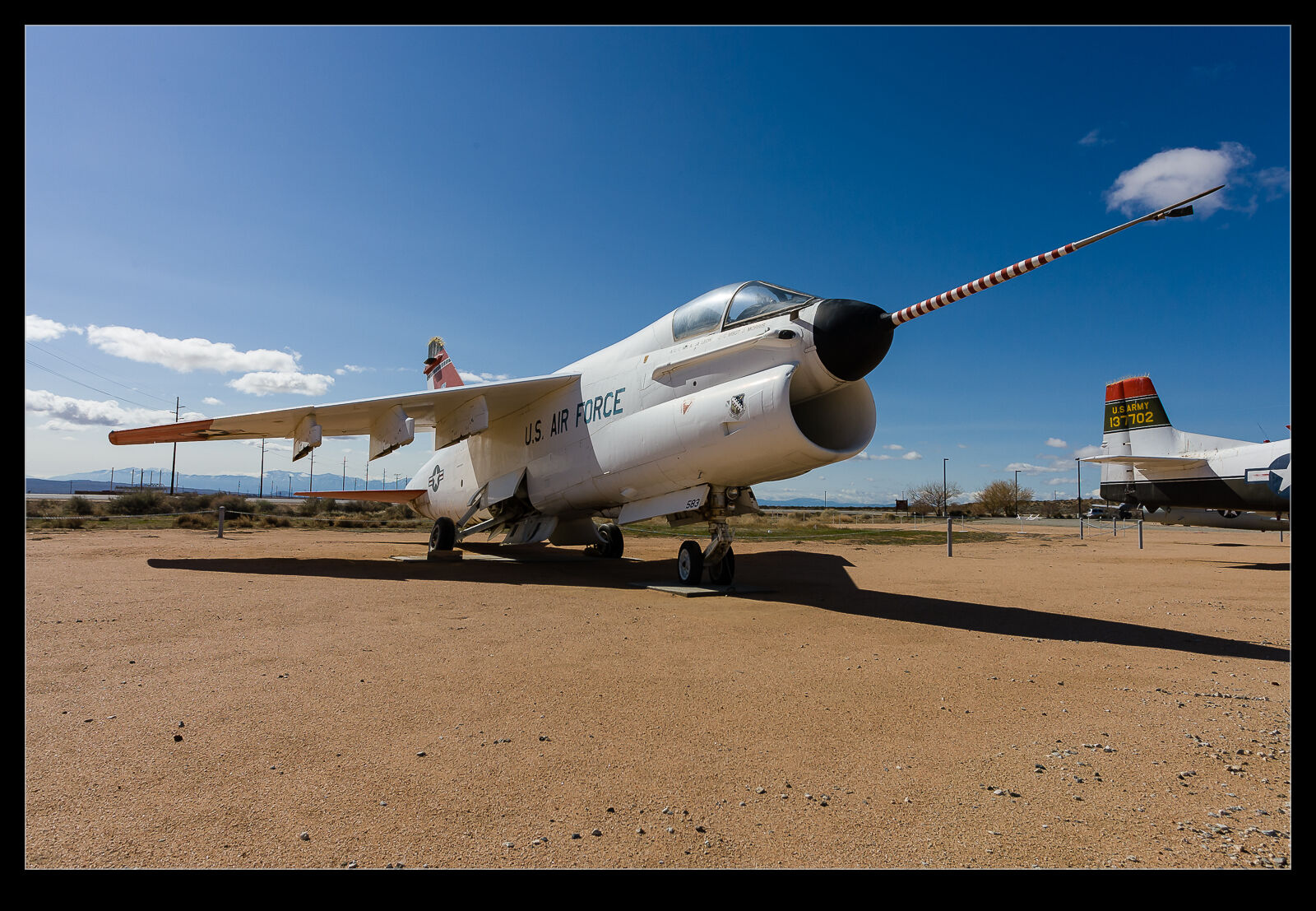 Edwards AFB has been the home to an amazing range of interesting aircraft types. Many of them have found their way to prominent museums around the country given the significance of what they achieved. Others never found interest and got disposed of. Some never lasted long enough to be preserved given the hazardous nature of what they did. However, there was a storage program for the rest and Edwards has a museum of some of these preserved airframes.
Edwards AFB has been the home to an amazing range of interesting aircraft types. Many of them have found their way to prominent museums around the country given the significance of what they achieved. Others never found interest and got disposed of. Some never lasted long enough to be preserved given the hazardous nature of what they did. However, there was a storage program for the rest and Edwards has a museum of some of these preserved airframes.
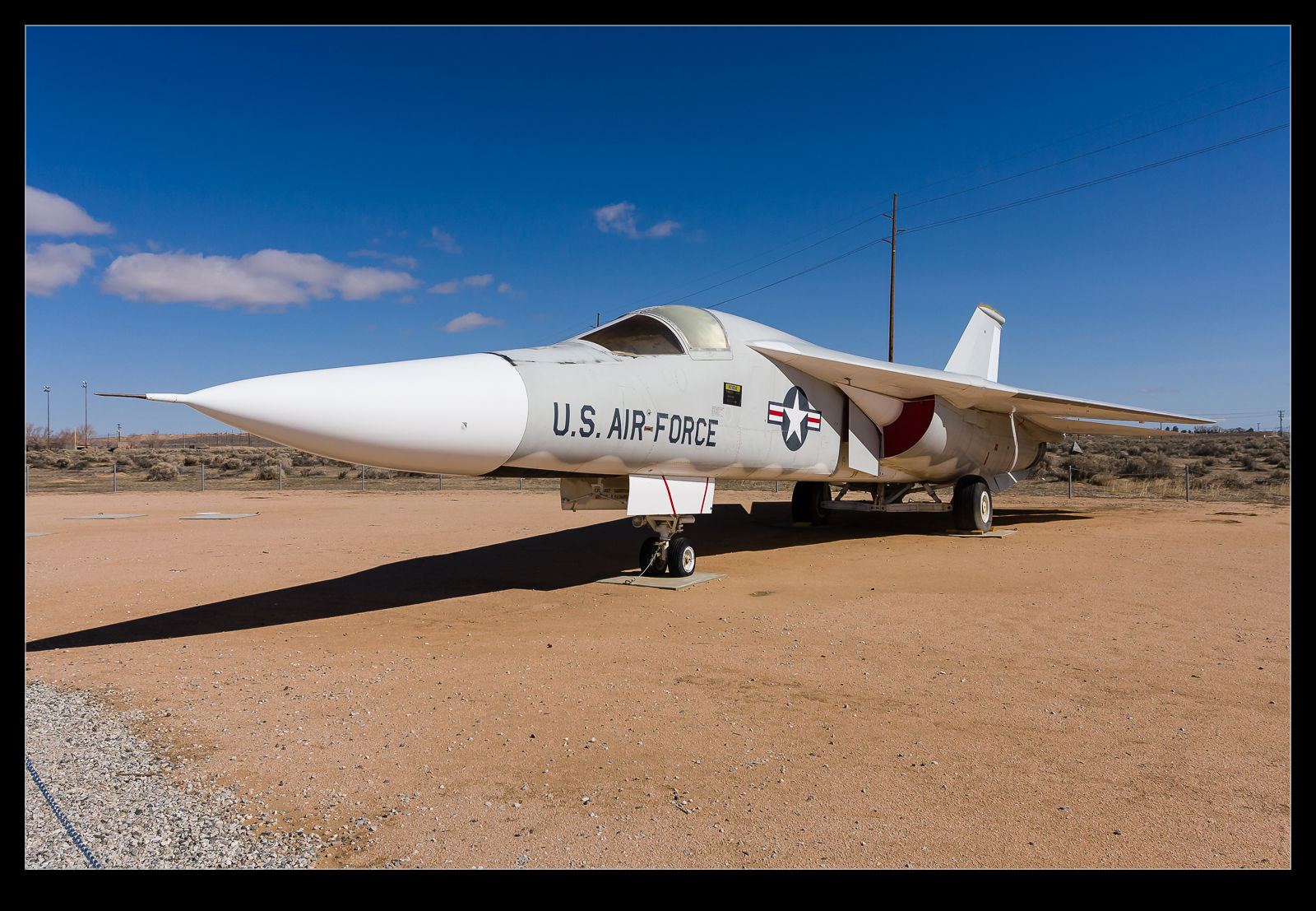 I haven’t been to Edwards for a long time so I don’t know what the current situation is with the collection but I did get to check it out on a previous visit. The collection was mainly front line types that had been used for testing purposes. (This is the USAF side of things rather than the NASA collection.) There are some types there that I didn’t see which I would like to have done like the YA-7F. However, there was a test A-7D with an air data boom. Here are some of the shots I got that day. I also shot a couple of other jets that were away from the rest but these were only with my phone and phone quality in those days was not what it is now.
I haven’t been to Edwards for a long time so I don’t know what the current situation is with the collection but I did get to check it out on a previous visit. The collection was mainly front line types that had been used for testing purposes. (This is the USAF side of things rather than the NASA collection.) There are some types there that I didn’t see which I would like to have done like the YA-7F. However, there was a test A-7D with an air data boom. Here are some of the shots I got that day. I also shot a couple of other jets that were away from the rest but these were only with my phone and phone quality in those days was not what it is now.
G600 Test Jet
 I heard a rumor about a Gulfstream test jet being at Boeing Field. With a Saturday morning free, I decided to head over and investigate. One of the things I had seen suggested it might be the G700. Since that had only recently had its first flight, I was surprised it would be operating out of the west coast rather than Georgia so I decided to try and see it. Of course, it wasn’t the G700. Instead it was a G600 test airframe. Since I had not seen a G600, I was still pleased to catch it. The weather was crummy and it was due to go back to Savannah so I was wondering what sort of shots I would get.
I heard a rumor about a Gulfstream test jet being at Boeing Field. With a Saturday morning free, I decided to head over and investigate. One of the things I had seen suggested it might be the G700. Since that had only recently had its first flight, I was surprised it would be operating out of the west coast rather than Georgia so I decided to try and see it. Of course, it wasn’t the G700. Instead it was a G600 test airframe. Since I had not seen a G600, I was still pleased to catch it. The weather was crummy and it was due to go back to Savannah so I was wondering what sort of shots I would get.
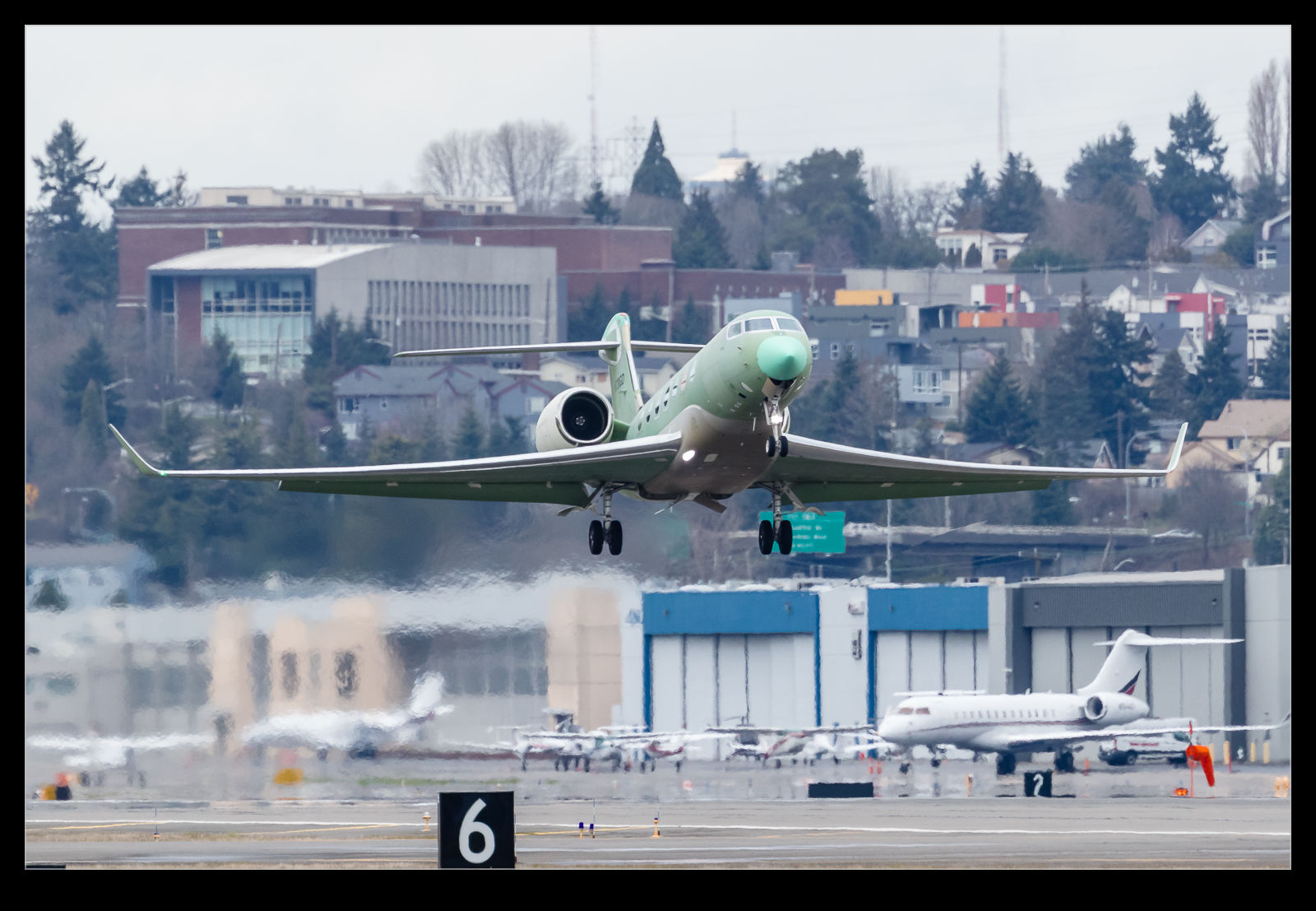 Like any test jet, it didn’t depart when scheduled. It was an hour later than planned when it rolled to the runway and then hung around at the hold point for ages. Then it turned and taxied down towards the end where I was. I couldn’t see it departing in the opposite direction because SeaTac was still flowing to the south and wasn’t showing any sign of changing. It came down past me to the end of the runway and then turned around and taxied back the way it had come. After all of this it departed into the overcast.
Like any test jet, it didn’t depart when scheduled. It was an hour later than planned when it rolled to the runway and then hung around at the hold point for ages. Then it turned and taxied down towards the end where I was. I couldn’t see it departing in the opposite direction because SeaTac was still flowing to the south and wasn’t showing any sign of changing. It came down past me to the end of the runway and then turned around and taxied back the way it had come. After all of this it departed into the overcast.
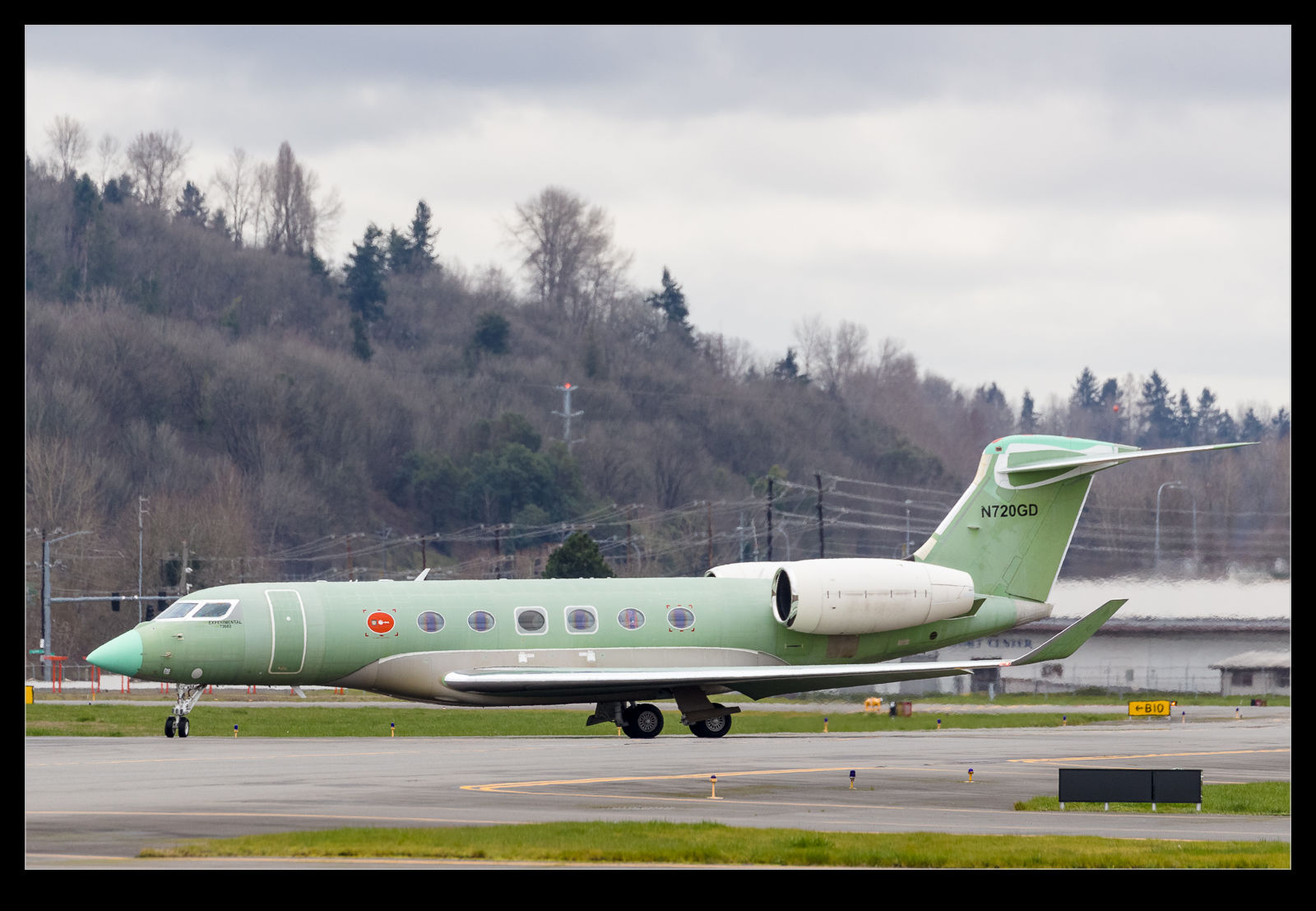 Given that I was expected a departure from the far end and a swift climb into the gloom, I hadn’t expected to get many shots I was pleased with. Therefore, this sojourn down to my end and back provided plenty of chances to get a bunch of shots so this turned out to be a lot luckier than expected. I am also a sucker for a jet in primer so thrown in a few instrumented panels for test purposes and I am a happy camper!
Given that I was expected a departure from the far end and a swift climb into the gloom, I hadn’t expected to get many shots I was pleased with. Therefore, this sojourn down to my end and back provided plenty of chances to get a bunch of shots so this turned out to be a lot luckier than expected. I am also a sucker for a jet in primer so thrown in a few instrumented panels for test purposes and I am a happy camper!
Trying to Catch the 777X Airborne
 The first flight of the 777X took place while I was out of the country which annoyed me quite a bit. Having seen the things sitting around at Everett for ages and even watched the taxi trials, I was in the wrong place when they finally got airborne. However, with an extensive flight test program to come, I knew there would be other opportunities. I did manage to be at Boeing Field for a departure on one of the flights. Conditions weren’t great, though.
The first flight of the 777X took place while I was out of the country which annoyed me quite a bit. Having seen the things sitting around at Everett for ages and even watched the taxi trials, I was in the wrong place when they finally got airborne. However, with an extensive flight test program to come, I knew there would be other opportunities. I did manage to be at Boeing Field for a departure on one of the flights. Conditions weren’t great, though.
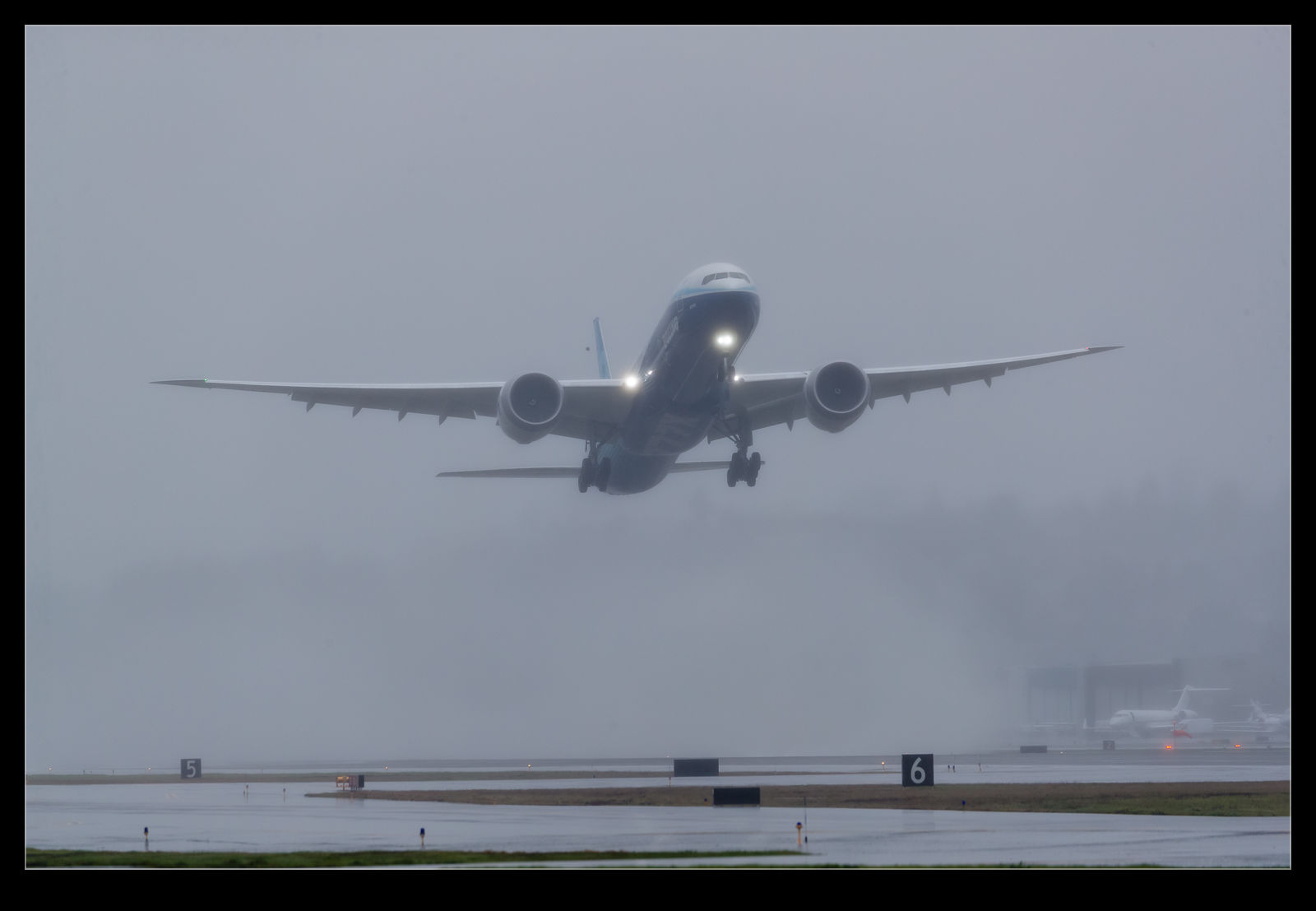 With the viewing area closed while Boeing parks 737s wherever it can find a space, I was a long way from the rotation point. It was in the rain as it rolled and, while it stayed below the clouds until well past me, things were not ideal. Still, I had seen it fly.
With the viewing area closed while Boeing parks 737s wherever it can find a space, I was a long way from the rotation point. It was in the rain as it rolled and, while it stayed below the clouds until well past me, things were not ideal. Still, I had seen it fly.
 On another occasion I was able to be there when it returned. This had also been a day with some pretty crummy conditions but this time I was seeing the weather starting to improve as the day wore on. A little bit of a wait while they flew test activities over Central Washington was not such a bad thing. Indeed, as they turned for home, the sun was coming out. However, the wind was not abating!
On another occasion I was able to be there when it returned. This had also been a day with some pretty crummy conditions but this time I was seeing the weather starting to improve as the day wore on. A little bit of a wait while they flew test activities over Central Washington was not such a bad thing. Indeed, as they turned for home, the sun was coming out. However, the wind was not abating!
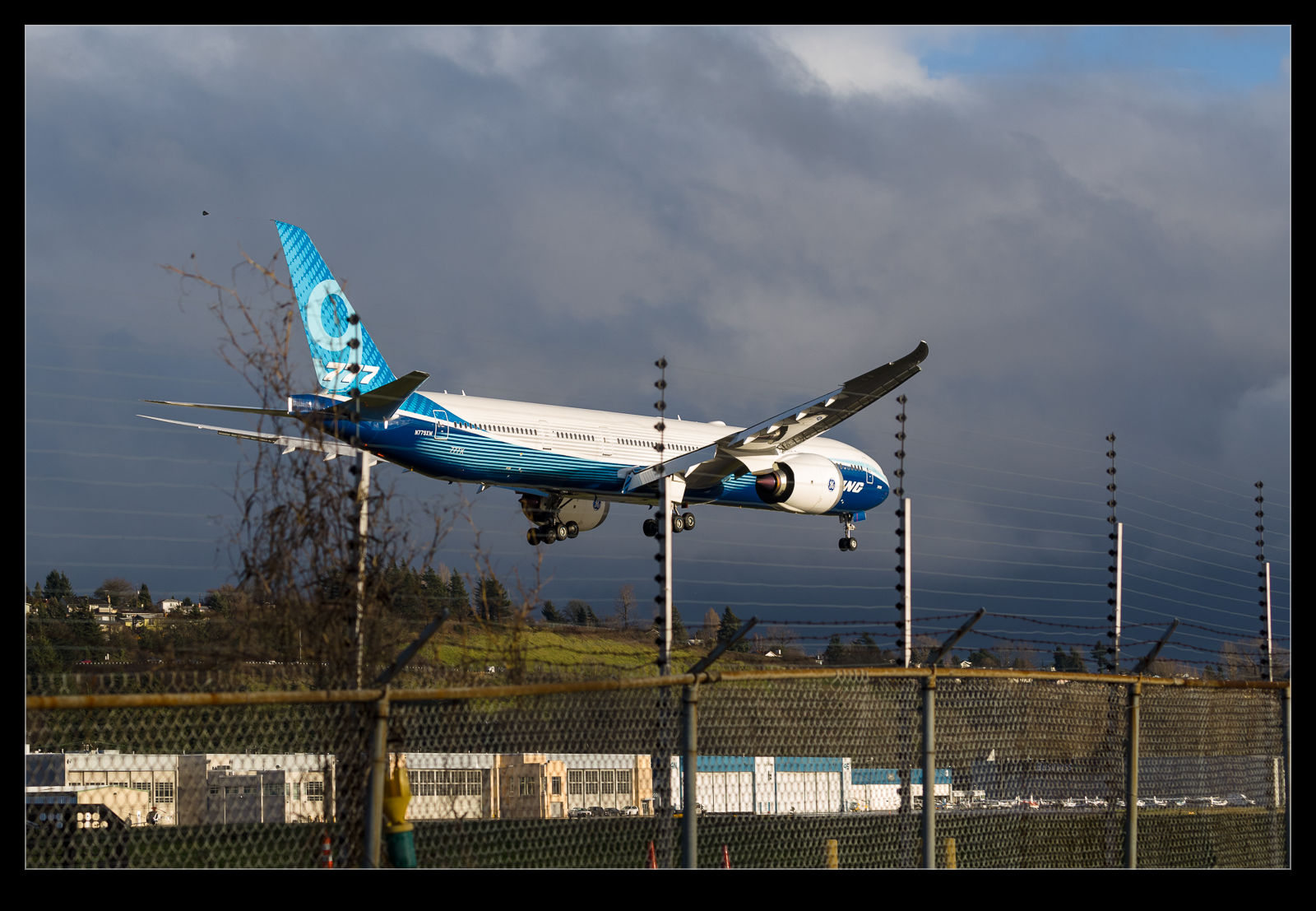 When they called up on approach, I wandered to one side to see how far up the approach I could see. Despite me being to the right side of the runway from their perspective, when I first got a good shot, the jet was actually pointing beyond me to the right. The crosswind was obviously pretty strong. Early in the flight test program, I wonder whether they really wanted to be testing this capability. Of course this then meant I got a head on view as they got closer before running past me. Shots in nice light! Happy guy. In the next year we shall see plenty of these but, for now, I am happy to have got something reasonable of this airframe off the ground.
When they called up on approach, I wandered to one side to see how far up the approach I could see. Despite me being to the right side of the runway from their perspective, when I first got a good shot, the jet was actually pointing beyond me to the right. The crosswind was obviously pretty strong. Early in the flight test program, I wonder whether they really wanted to be testing this capability. Of course this then meant I got a head on view as they got closer before running past me. Shots in nice light! Happy guy. In the next year we shall see plenty of these but, for now, I am happy to have got something reasonable of this airframe off the ground.
